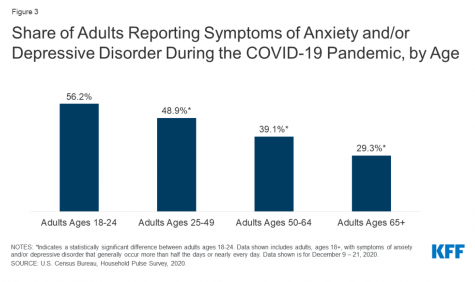A Clear and Present Danger to Mental Health
March 8, 2021
The overwhelming feeling of fear during a pandemic is scarring. Seeing friends and family seems like a tradeoff; while it is nice to see loved ones, it is hard on mental health. People feel anxiety ridden over everyday occurrences that used to be simple, like spending time with others. No matter what, the thought of contracting the virus makes it impossible to feel complete and total comfort. Even staying safe and attending school can be taxing. Staring at the computer screen for almost the entire day can feel grueling and unmotivating. Where’s the middle ground? There is none. Living life either way is harmful to mental health.
The decline in mental health is currently being studied extensively. The Centers for Disease Control and Prevention (CDC) says that “4 in 10 adults in the U.S. have reported symptoms of anxiety or depressive disorder.” Those who have lost jobs since the COVID-19 outbreak are very susceptible to issues like substance abuse, depression, low self esteem, and suicidal thoughts. However, women, essential workers, and people of color are more likely to experience these issues, where people of color are unfortunately having trouble accessing mental health services. A Kaiser Family Foundation (KFF) survey found that “13% of adults reported new or increased substance use due to coronavirus-related stress, and 11% of adults reported thoughts of suicide in the past 30 days.” Once the lockdowns started in March 2020, overdose deaths increased noticeably (The Implications of COVID-19 for Mental Health and Substance Use, KFF + Coping With Stress, CDC). Clearly, the pandemic has led to a frightening decline in mental health, where all people no matter their background or situation are feeling the emotional and psychological impacts of COVID.
Students have had an extremely difficult experience with the pandemic as well. School closures, social distancing, quarantine, and other major changes to life have caused emotional problems. For instance, 20% of college students report that their mental health has worsened (School During The Pandemic: Mental Health Impacts on Students). Most college students had to spend at least their spring semester at home last year. Many have had to attend one semester or none at all for the 2020-2021 school year as well. Not only are college students facing school closures due to COVID, high school students all around the country are too. High school students have lost the structured routine of attending each class with focus and an expected participative behavior to losing motivation and rigidity. High school students now approach school with a hopeless attitude, knowing that they are losing important milestones in their lives. Not only is academic life for students grim, social life is too. Students went from seeing friends at school and working with peers to an immediate neglect of social interaction in virtual school. Even students who attend in person school are not allowed to eat lunch with their friends. There was barely a warning or transition to virtual school in March and students were forced to adjust instantly as a result.
Ms. Mantashian, the Student Assistance Counselor who helps students with any issues they may be having, was interviewed on her perspective on mental health during the COVID-19 pandemic. Ms. Mantashian believes mental health has generally worsened since the outbreak, as she notices students “experiencing low motivation, inattention, isolation, anhedonia (inability to feel pleasure), excessive sleep during the day, as well as a decrease in attending to their activities of daily living (showering, brushing teeth, dressing).” She has also seen an increase in anxiety that results in “work avoidance” and occurence that surprised her, which is “an increase in social anxiety symptoms as a result of the Zoom camera.” A cause of Zoom-related social anxiety is breakout rooms, due to the unpredictability of them. However, she noticed that many students feel relief about virtual classes, as “the environment does not permit typical socialization or potential exclusion. Many students are focusing less on maintaining superficial social connections and placing more effort into strengthening a few genuine relationships with friends.” It is important to look at the bright side of unfortunate situations, and it is true that there are definite pros to the virtual setup of school this year, just like Ms. Mantashian discussed. On the other hand, if a student feels that online school has more cons, they should consider in-person learning, as “a change in environment makes a big difference.” If in-person learning is not possible at the moment, changing workspaces to areas outside of the bedroom will increase motivation and focus in school, as “students are having a hard time maintaining motivation to complete work in the virtual environment which leads to increased anxiety, avoidance, and feeling overwhelmed with panic at the final hour of submission.” Ms. Mantashian also stresses that imperfect assignments are okay! Giving yourself a break, socializing with peers, spending time outside, or simply taking time away from the computer is incredibly beneficial to mental health and happiness. All in all, Ms. Mantashian points out that “adolescence is a developmental stage when mental health symptoms begin to surface for some. It is likely the pandemic has exacerbated these symptoms or triggered an initial onset.” This has definitely become more obvious to parents and family, as being home all day makes hiding mental health struggles harder. Ms. Mantashian thinks discussion about mental health has improved, especially at home. “We are all dealing with a collective trauma and with that comes feelings of helplessness, fear, and confusion. It’s important that we recognize these feelings and seek help when our functioning is impacted.” Ms. Mantashain finally wants to remind all students that “you have teachers, counselors, and other support staff here to help you every step of the way. You do not have to do this alone. Please consider scheduling an appointment with your school counselor. I am also available for counseling.”
Unfortunately, there is no way to travel to the past and make different choices as a country to avoid the changes in our lives due to COVID-19. The world must move forward and live each day to the fullest. The CDC recommends the following to improve mental health during this pandemic: 1) take breaks from watching the news, as it can be overwhelming 2) phone breaks are necessary, especially since most of the day revolves around virtual meetings and activities 3) exercise 4) sleep a minimum of 8 hours a day 5) communicate with loved ones about mental health 6) reach out to others and ask how they are feeling (Coping with Stress, CDC). The world is tired of hearing about these “unprecedented times.” Everyone wants to live life freely and without worry about whether their life is in danger. As COVID-19 lockdowns approach its one year anniversary and vaccines are finally being distributed, having hope is essential for emotional wellbeing. The finish line is in sight.






